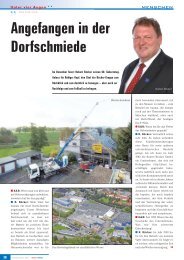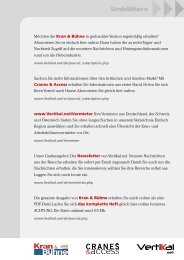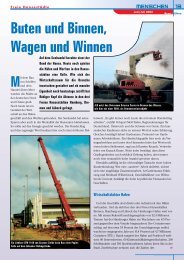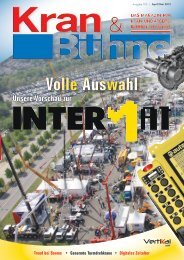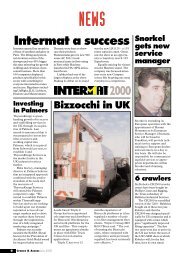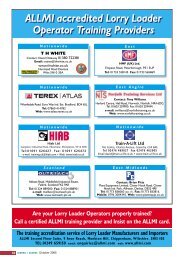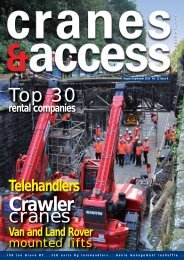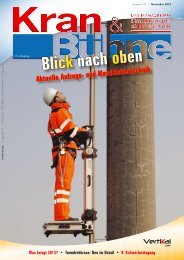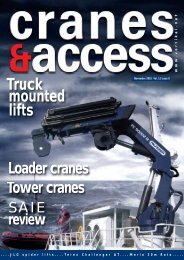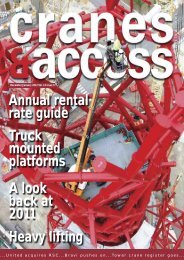Truck mounted lifts Taxi cranes Top 30 rental companies - Vertikal.net
Truck mounted lifts Taxi cranes Top 30 rental companies - Vertikal.net
Truck mounted lifts Taxi cranes Top 30 rental companies - Vertikal.net
You also want an ePaper? Increase the reach of your titles
YUMPU automatically turns print PDFs into web optimized ePapers that Google loves.
taxi <strong>cranes</strong> c&a<br />
Chinese answer<br />
Ask the average crane man to name<br />
the most popular mobile crane built<br />
today and you’ll get all manner of<br />
responses, and yet the answer is<br />
not a close run thing. 25 tonne truck<br />
<strong>cranes</strong>, once the bedrock of the<br />
European taxi crane market, make<br />
up the vast majority of mobile<br />
<strong>cranes</strong> built today. However<br />
virtually all of them are built and<br />
sold in China’s domestic market.<br />
The <strong>cranes</strong> are so inexpensive you<br />
would think that they would be the<br />
solution to Europe’s low <strong>rental</strong> rates<br />
for this size of crane? Think again<br />
though, in spite of all the moaning<br />
about <strong>rental</strong> rates crane <strong>rental</strong><br />
<strong>companies</strong> do not seem ready to<br />
move back to truck <strong>cranes</strong> anytime<br />
soon – at the moment it is quality,<br />
specification, resale values and<br />
regulations that prevent this<br />
happening, at least on the surface.<br />
Crowland Cranes and Zoomlion<br />
have done more than anyone to<br />
deliver a product that is up to<br />
European standards and<br />
expectations and yet buyers are<br />
not exactly flocking to their door,<br />
although trials have gone well.<br />
Perhaps the industry needs to<br />
follow Geoffrey Marsh of the UK’s<br />
Marsh Plant view and focus on<br />
financial returns for each crane,<br />
rather than how sexy the equipment<br />
looks with their name on the side?<br />
The latest taxis<br />
Moving back to the All Terrains,<br />
the smallest city <strong>cranes</strong> from the<br />
mainstream suppliers are now in<br />
the <strong>30</strong> to 50 tonne range and one<br />
that looks set to change the market<br />
or at least have a profound impact<br />
on it is the Liebherr LTC1045-3.1.<br />
With its single movable and<br />
elevating cab it is ideally suited to<br />
local taxi work being compact,<br />
Crowland Cranes and Zoomlion<br />
have done more than anyone to deliver<br />
a product that is up to European<br />
standards and expectations<br />
quick, fully self- contained and<br />
versatile. Another new addition is<br />
the slightly larger capacity Terex<br />
Challenger 3160 (and 3180 for the<br />
UK market).<br />
In our February 2012 issue of<br />
Cranes and Access we took an<br />
in-depth look at both of these<br />
<strong>cranes</strong> – the result of the major<br />
crane manufacturers re-thinking<br />
the design concepts of smaller<br />
capacity mobile <strong>cranes</strong>.<br />
The LTC 1045-3.1 is Liebherr’s<br />
smallest mobile crane and has<br />
several unconventional features –<br />
the most striking is its telescopic<br />
boom <strong>mounted</strong> single cab which<br />
can be moved front and back giving<br />
optimal road visibility or when on<br />
site in lifting mode. There is also the<br />
option of elevating the arm to an<br />
eye level height of almost eight<br />
metres particularly useful when<br />
working close to obstructions or<br />
loading into a container or ship.<br />
Terex says that the Challenger is<br />
“a new breed of one-man taxi<br />
crane” carrying everything needed<br />
for one person to drive to site, rig<br />
and set-up the crane and carry out<br />
the lift – without having the need to<br />
work at height. The boom can be<br />
lowered to five degrees below the<br />
horizontal, allowing quick and easy<br />
ground level assembly of the<br />
extension or re-reeving of the hook<br />
block. The three sheave Vario-Hook<br />
system with 18mm (six tonne<br />
single line pull) rope reduces<br />
rigging time and the weight of<br />
on-board equipment.<br />
Working within the 12 tonnes per<br />
axle (36 tonne GVW) European road<br />
regulations, the 3160 has a capacity<br />
of 35.6 tonnes at four metres and<br />
can also conform to 10 tonne axle<br />
load requirements if needed, using<br />
its counterweight self-rigging ability<br />
34 <strong>cranes</strong> & access August/September 2012<br />
Liebherr’s smallest<br />
mobile crane has an<br />
optional elevating<br />
cab particularly<br />
useful when<br />
working close<br />
to obstructions<br />
for a vehicle weight of less than<br />
<strong>30</strong> tonnes. For the UK market the<br />
Challenger 3180 comes with an<br />
extra 5.3 tonnes of counterweight,<br />
all wheel drive - rather than 6x4x6 -<br />
and can carry the 16 metre bi-fold<br />
swingaway extension on board<br />
with 800kg of accessories such as<br />
outrigger pads, chains and hook<br />
block for a fully equipped GVW 46<br />
tonnes or 15.5 tonnes an axle.<br />
Technology may be a saviour?<br />
The true test of the taxi crane is its<br />
speed, manoeuvrability and ability<br />
to carry out several jobs a day.<br />
This increase in utilisation is<br />
essential if <strong>rental</strong> <strong>companies</strong> are<br />
to make money in this end of the<br />
business. When things go well<br />
and with a good hire desk/<br />
dispatcher at work this can still<br />
be a highly lucrative business.<br />
Looking at it this way it is easy to<br />
see how new technology might<br />
even make this sector more efficient.<br />
Developments such as GPS<br />
and telematics allow dispatchers<br />
to see exactly where the crane is<br />
The Terex Challenger is “a<br />
new breed of one-man taxi<br />
crane” carrying everything<br />
needed for one person<br />
to operate<br />
and speak to the operator for<br />
updates on how a given job is<br />
going. It is even possible for the<br />
operator to carry a credit card<br />
machine to take payment from<br />
cash customers helping with the<br />
industry’s serious on-going credit<br />
control issues.<br />
In a busy city environment it is also<br />
possible to envisage <strong>cranes</strong> parking<br />
up waiting for the next job rather<br />
than returning early to base. With<br />
live tracking the dispatcher can<br />
often tell when the job has been<br />
completed before the operator calls<br />
it in. Some <strong>companies</strong> are also<br />
looking hard at <strong>rental</strong> yields offering<br />
lower prices for customers who can<br />
afford to have a lift done on standby<br />
rather than at a specific time.<br />
While mobile <strong>cranes</strong> have generally<br />
moved up in capacity vacating<br />
some of the smaller work to<br />
telehandlers and loader <strong>cranes</strong>,<br />
the mobile taxi crane is far from<br />
dead and technology and smarter<br />
working practices may yet<br />
encourage a renaissance?





